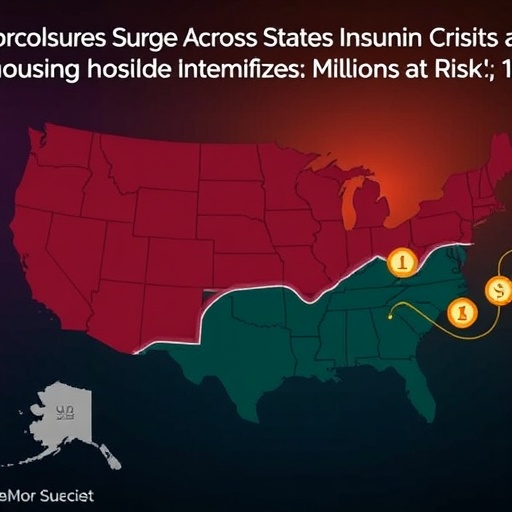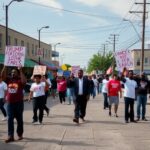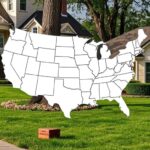In a stark reminder of economic fragility, Foreclosures have skyrocketed by 25% nationwide in the first half of 2024, leaving thousands of American families on the brink of losing their homes amid an escalating housing crisis. This surge, driven by soaring mortgage rates and unrelenting inflation, is not just a financial footnote—it’s a human tragedy unfolding in suburbs and cities alike, with homeowners grappling with payments they can no longer afford.
The data paints a grim picture: According to the latest report from ATTOM, a leading provider of real estate data, foreclosure filings reached 93,000 in the second quarter alone, up sharply from the previous year. This isn’t a localized blip; it’s a national wave crashing over the American dream, affecting working-class families from California to Florida. As costs for everything from groceries to utilities climb, the strain on homeowners has reached a breaking point, exposing deep cracks in the U.S. housing market.
Rising Costs Fuel Foreclosure Firestorm
The root of this foreclosure frenzy lies in the perfect storm of economic pressures battering homeowners. Mortgage rates, which hovered around 3% just a few years ago, have now climbed to over 7%, according to Freddie Mac’s Primary Mortgage Market Survey. For the average homeowner with a $300,000 loan, this translates to an additional $500 or more per month in payments—money that many families simply don’t have amid stagnant wages and rising living expenses.
Inflation, lingering at 3.2% as per the Bureau of Labor Statistics, has compounded the issue. Everyday costs like energy bills and property taxes have surged, with some states seeing increases of up to 15%. “It’s like death by a thousand cuts,” says Dr. Elena Ramirez, an economist at the Urban Institute. “Homeowners who bought during the low-rate era are now facing adjustable-rate mortgages resetting at unaffordable levels, pushing Foreclosures higher.”
Consider the case of the Thompson family in suburban Ohio. Mark Thompson, a 45-year-old factory worker, refinanced his home in 2021 at a teaser rate. Now, with rates resetting, his monthly payment has jumped from $1,200 to $1,800. “We skipped vacations, cut back on everything, but it’s not enough,” Thompson told reporters last month. Stories like his are multiplying, with the Mortgage Bankers Association reporting delinquency rates at 4.2%, the highest since the 2008 financial crisis.
This economic impact extends beyond individual households. Foreclosed properties flood the market, depressing home values in affected neighborhoods by as much as 10-15%, per Zillow’s latest analysis. It’s a vicious cycle: lower property values mean less tax revenue for local governments, straining public services and schools, while banks face mounting losses on bad loans.
Hardest-Hit Regions: A Map of Despair
While the foreclosure surge is nationwide, certain regions are bearing the brunt, turning quiet communities into epicenters of the housing crisis. Florida leads the pack with over 12,000 foreclosure filings in Q2 2024, a 40% increase year-over-year, according to RealtyTrac. The state’s vulnerability stems from its high concentration of retirees on fixed incomes, coupled with hurricane-related repair costs that insurance often fails to cover fully.
Texas isn’t far behind, with filings up 30% in major metros like Houston and Dallas. Here, the oil industry’s volatility has left many energy sector workers unemployed or underemployed, unable to keep up with home payments. “In Texas, we’ve seen a perfect alignment of job losses and rising rates,” notes Sarah Jenkins, a real estate analyst at CoreLogic. “Foreclosures in these areas are not just numbers; they’re families being uprooted after decades of stability.”
Even rust-belt states like Illinois and Michigan are seeing spikes, with Chicago reporting a 28% rise in filings. These areas, still recovering from manufacturing declines, now face a double whammy: legacy foreclosures from the Great Recession overlapping with new ones driven by post-pandemic economic shifts. A
- California: 9,500 filings, up 22%, fueled by tech layoffs in Silicon Valley.
- New York: Urban foreclosures rising 18%, as remote work ends force returns to high-cost city living.
- Georgia: Atlanta’s boom-bust cycle leads to 11% increase, hitting first-time homeowners hardest.
breakdown from ATTOM highlights how diverse the pain points are.
Demographically, the impact is uneven. Minority homeowners, particularly Black and Hispanic families, face foreclosure rates 50% higher than white counterparts, per a Federal Reserve study. This disparity underscores systemic issues in lending practices and wealth gaps, amplifying the housing crisis’s role in widening inequality.
Political Inaction Leaves Homeowners in Limbo
Despite the mounting toll, politicians from both parties have been strikingly silent on the foreclosure epidemic, treating it as a peripheral issue amid louder debates on inflation and border security. In Congress, housing legislation has stalled; the last major relief package, part of the 2021 American Rescue Plan, expired without renewal, leaving no safety net for struggling homeowners.
Democrats, focused on climate and social justice agendas, have proposed rent control measures but overlooked foreclosure prevention. Republicans, emphasizing deregulation, argue that market forces will self-correct, yet they’ve blocked extensions to programs like the Homeowner Assistance Fund. “It’s bipartisan neglect,” criticizes Rep. Maria Gonzalez (D-CA), one of the few voices raising alarms. “We’re watching families lose their homes while Washington plays politics.”
This oversight isn’t accidental. Lobbying from real estate and banking sectors, which donated over $100 million to campaigns in the 2022 cycle per OpenSecrets, influences priorities. Meanwhile, state-level responses vary wildly: Nevada has expanded mediation programs to delay foreclosures, reducing filings by 15%, while others like Arizona offer minimal aid, seeing rates climb unchecked.
The human cost is evident in eviction courts overflowing with cases. In Maricopa County, Arizona, judges report a 35% caseload increase, with many homeowners representing themselves due to legal aid shortages. “The system is broken,” says Judge Lisa Harper. “People are losing everything because help isn’t there.”
Real Stories Behind the Statistics: Homeowners Fight Back
Beyond the numbers, the housing crisis is a tapestry of personal battles. Take Lisa Chen, a single mother in Atlanta. After losing her job in the 2023 tech downturn, Chen’s mortgage payments became insurmountable. “I bought this house for my kids’ future,” she shares in a recent NPR interview. “Now, foreclosure notices are our reality. It’s heartbreaking.” Her story mirrors thousands: the CFPB reports that 1 in 5 homeowners sought forbearance in 2024, but many have exhausted options.
Community groups are stepping in where government lags. Organizations like the National Housing Law Project have assisted over 50,000 families with legal aid this year, negotiating loan modifications that avert foreclosure in 60% of cases. In Detroit, a grassroots initiative called Homeowners United has rallied neighbors to pressure banks for payment plans, successfully saving 200 homes in the past six months.
Experts like those at the Brookings Institution warn of broader ripple effects. “Foreclosures don’t just displace families; they erode community fabric,” says senior fellow Mark Muro. “Neighborhoods see crime rise, schools suffer, and economic mobility stalls.” Data supports this: A study by the Urban Institute found that post-foreclosure areas experience 20% higher vacancy rates, leading to urban decay and reduced property tax bases.
Yet, glimmers of resistance emerge. Some homeowners are turning to shared equity models or co-housing to pool resources, while fintech startups offer AI-driven refinancing tools to lower rates. Still, for most, the fight is uphill, with the economic impact of foreclosures projected to cost the U.S. economy $50 billion in lost productivity by 2025, per Moody’s Analytics.
2026 Midterms on the Horizon: A Wake-Up Call for Voters
As the foreclosure crisis deepens, its shadow looms large over the 2026 midterm elections, potentially reshaping political landscapes in key battleground states. With millions of homeowners feeling the squeeze, voter turnout could surge among affected demographics, turning housing into a flashpoint issue. Polls from Pew Research indicate that 62% of Americans view the housing crisis as a top concern, up from 45% in 2022.
In swing states like Pennsylvania and Wisconsin, where foreclosures have risen 20-25%, incumbents face backlash. “This could be the sleeper issue that flips seats,” predicts political analyst David Wasserman of the Cook Political Report. Candidates ignoring it risk alienating suburban voters, a bloc that delivered victories in recent cycles. Bipartisan proposals, like expanding FHA loan forgiveness, are gaining traction in think tanks, but implementation remains uncertain.
Looking ahead, experts urge swift action: Federal interventions such as rate caps or expanded assistance could stem the tide, potentially halving foreclosure rates by 2026. States are piloting programs too—California’s $1 billion homeowner relief fund has already prevented 10,000 evictions. For families like the Thompsons and Chens, the path forward hinges on whether leaders finally prioritize the housing crisis over partisan gridlock.
The stakes are high. If unaddressed, this surge in foreclosures could trigger a broader economic downturn, echoing the 2008 meltdown but with fewer safeguards in place. As 2026 approaches, the voices of displaced homeowners may force a reckoning, demanding policies that safeguard the American home against the storms of economic uncertainty.










